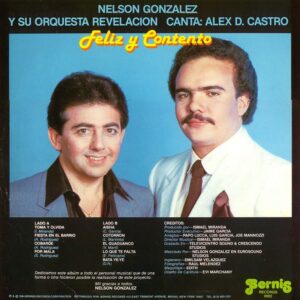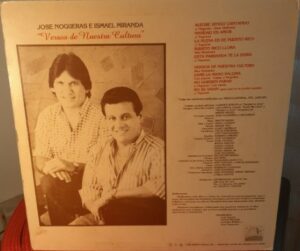This post is also available in:
 Español
Español
After a strong finish to his first decade as a solo artist (as we covered in Part 2), Ismael Miranda continued producing good Salsa albums towards the end of the Fania Records era. He even resurrected the Orquesta Revelación. But as the 80s progressed, Ismael would try his hand at Puerto Rican Christmas music and at the new Salsa Romántica.
Let’s explore how that worked out during his second decade as a solo artist.
The Return of Orquesta Revelación
Ismael Miranda began his second decade as a solo artist in the early ’80s with “The Master” (1983). Ismael produced a good album, with good musicians and good songs. Two songs were written by Tite Curet Alonso, one by Chiquitín García, and two by himself.
But despite the good production, the album was quickly forgettable. So for his next album, Ismael went back to another good collaboration, this time with the timeless Sonora Matancera.
“La Sonora Matancera & Ismael Miranda” (1984) was a well-produced album by the legendary Cuban band with Ismael as a guest artist. A couple of songs received good radio airplay, which helped to keep Ismael in the Salsa hit charts.

For his next solo project, which would turn out to be his last with the Fania label as it began to disintegrate, Ismael decided to go back to his origins to bring back the Orquesta Revelación with Nelson Gonzalez. They teamed up to produce two albums. One for Ismael Miranda and one for Nelson Gonzalez and the Orquesta Revelación.
Besides Nelson, the revival of the Revelación didn’t include any other members of that original 1973 band. However, just like a decade earlier, the Orquesta Revelación had some good up-and-coming young musicians, which included Alex D’Castro in the chorus and Wilfredo “Freddy” Rivera on bass, who would later go on to join El Gran Combo.
The album of Nelson Gonzalez y Orquesta Revelación, “Feliz y Contento” (1984), was the first of the two albums to come out. It was produced and directed by Ismael Miranda, but with Alex D’Castro on vocals. Ismael even wrote one of the songs.
Ismael’s “Una Nueva Visión” (1985) followed a year later. This was another well-produced album by Ismael Miranda and with better results than his previous two solo recordings. Ismael wrote one song, Johnny Ortiz another, and Tite Curet Alonso contributed four songs, including a sequel to Galera 3, and co-wrote a fifth one.
Guest musicians included Amuni Nacer (synthesizer), Jan Duclerc (trumpet), Giovanni Hidalgo (percussion), and Antonio “Toño” Rivera (trombone); all young and future stars.
With La Sonora Matancera and “Una Nueva Visión“, Ismael Miranda kept his place as a top Salsa performer. But another collaboration opportunity made him change the course and style of his next recordings.
Ismael Miranda’s Christmas Spirit

Around 1986, José Nogueras knocked on Ismael’s door with the idea of a collaboration on a Christmas album project. The album, “Versos de Nuestra Cultura” became a huge hit, and almost all the songs continue to be played on the radio every Christmas season since its release. Among the close to 40 Christmas albums that José Nogueras has recorded up to this date, “Versos de Nuestra Cultura” remains at the top of my favorite Christmas albums.
The experience and exposure were so good for Ismael, that he decided to record three more Christmas albums of his own. These were all recorded in consecutive years, starting with “Motivos de Mi Tierra” (1987; along with the Salsa album “Por el Buen Camino“), then “Felicitándote” (1988), and finally “La Mano Maestra” (1989). This latter one was re-released with new cover art and much better results in 2012.
As Ismael focused the second half of the 1980s on Christmas recordings, he began to consider doing something different in the ’90s.
Ismael Miranda Enters Salsa Romántica
The new decade of the ’90s gave Ismael Miranda a motive to change the focus of his recordings. He returned to recording Salsa music but found that the craze of Salsa Romántica had taken over the preference of Salsa fans.
Therefore, his next four albums were in that new Salsa trend. But like many of his Salsa contemporaries that found success in the golden era of the 70s and early 80s, he finds it difficult to find success in this new craze, known as “Salsa monga” by fans of the hardcore Salsa, who are equally evasive of these new recordings.
So how does Ismael adjusts and navigates the rest of the 90s? That will be the focus of the next part of this series.


[…] Ismael Miranda Music Legend Part 3; 2nd Decade Solo […]